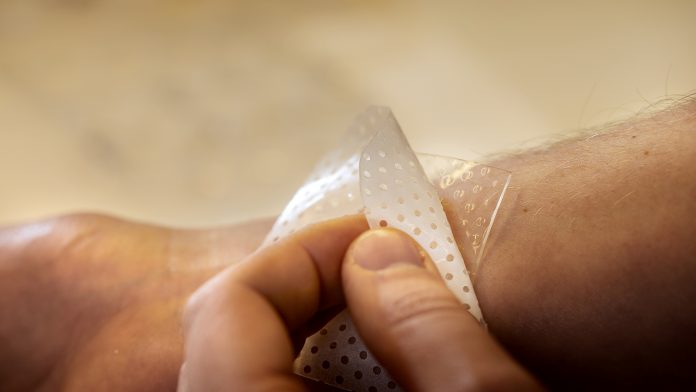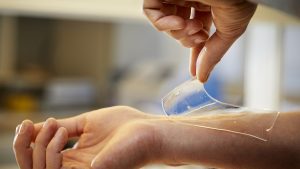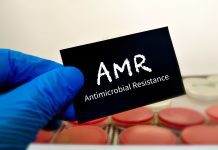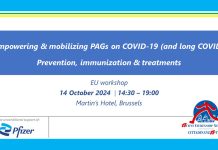
Using revolutionary technology, hydrogel wound care can help prevent unnecessary infection and heal wounds before they become chronic.
The benefits of employing antimicrobial peptides in wound care have been researched for years, but unfortunately as the peptide degrades quickly upon contact with bodily fluids it was impossible to actually employ as it would simply break down before it could have a positive impact. However, researchers at Chalmers University of Technology, Sweden, have developed a new material, a hydrogel, that suspends and protects the peptides, meaning they do not break down as readily. This innovative new technology will allow peptides to be used in dressings, as wound care, for the very first time and due to the unique nature of the peptides this technology can even be used to treat wounds that have antibiotic resistant bacteria. Martin Andersson, who led the research that developed this technology, spoke to Health Europa Quarterly (HEQ) about the benefits of this innovative product.
Can you outline some of the key challenges currently facing the management and treatment of wounds?
The big challenge when managing and treating wounds is infection. If the wounds get infected, it can greatly hamper the healing process and sometimes you can have such a severe infection that it could become fatal. Another challenge is that of chronic wounds, these are wounds that never heal, sometimes growing, causing extended discomfort to the patient and often requiring surgical intervention. Chronic wounds are especially difficult when dealing with patients who have other diseases, such as diabetes, that affect their ability to heal. Also, if patients are on certain drug treatments that limit their immune system their wounds become more difficult to treat. When combined, chronic wounds and the risk of infection are the biggest challenges we face within wound care.
What beneficial properties are present in the new hydrogel to promote wound healing?
The hydrogel focuses on eradicating bacteria that is present in the wound and in the surrounding skin and it is very effective as it has a rapid, almost immediate, killing effect. It is what is known as a contact killing device, so as soon as the bacteria gets in contact with the device, it is killed. It also attaches to the surface, therefore as you remove the wound patch you also remove the bacteria. One of the key benefits here is that it is very selective towards bacteria, but at the same time, it has a broad efficiency when it comes to different types of bacteria including gram-negative, gram-positive or resistant strains. It has also been proven that it has very low toxicity, so it does not cause irritation or pain when applied to the skin. Low toxicity is highly beneficial when healing wounds because if a treatment has any toxicity present, it can affect the tissue-forming cells and hamper the healing process. Furthermore, because it is a hydrogel that contains a lot of water, it creates a moist environment for the wound, which is ideal for promoting healing.
What advantages does the hydrogel offer over traditional wound care practices?
It is a quicker process. As a device it does not leach out any substance into the wound, ensuring that it stays as a local effect and does not need to be taken up by the body in any way. And because of that it is not dependent on the release, you do not need to build up a certain dosage or certain concentration, which is a common thing with many other devices that do release substances, in which you must reach a specific therapeutic dosage before the product will work effectively.
In terms of the material’s functionality, we are really trying to mimic parts of our own innate immune system. The ultimate goal of peptides is something that has been known for many decades, there are thousands of them that have been identified and they are in all living things, it is our natural way of trying to kill bacteria to hinder infections. Our immune system, if it is healthy and strong, will keep us from getting infections but when it is weakened or hampered in any way we begin to get these problems with wound healing. When you look at the mechanism of how these antimicrobial peptides are being used, you can see it is a very local effect, the immune cells, when you get an invasion, get activated, and they start to produce these peptides in high quantities at the site of the infection. If you can achieve a relatively high concentration of these peptides they can kill the bacteria and hinder infection.

Caption: The hydrogel focuses on eradicating bacteria that is present in the wound with a rapid killing effect.
However, the problem has been to clinically translate these peptides, because, first of all, they are very unstable, they are very sensitive, and they are degraded by enzymes that are present in our blood. It is difficult to treat with peptides systematically, because as soon as it gets into our bodies, it is just matter of seconds before they are degraded beyond use. If you want to locally administer the peptides directly into the wound, they will only be active for a few minutes or so because they will degrade very quickly. That is where our innovation comes in, that we have been able to make a material that retains these killing effects, but at the same time increases the stability of the peptide, allowing them to work for days instead of minutes. That is when we start to see the possibilities for use in a clinical setting, because you can use these materials for multiple days before you need to change them and in that time they will tackle the infection and promote healing.
Aside from the application of improved wound dressings, in what other ways could healthcare professionals minimise the risk of infection when treating difficult wounds?
There are the traditional ways of minimising infection of course such as maintaining good levels of hygiene with regular hand washing and disinfection, as is common practice. However, it is a complex subject, when talking with clinicians in Sweden I discovered that although operating theatres are getting cleaner infections rates remain consistent, even rising in some instances. Now, with the increased threat of resistant bacterial strains it makes it much more difficult, because in some procedures, around 20% of the patients could get infections, and if they get the resistant strains, we lack treatments for them. It is important to find ways of lowering the rates of infection. And I think that this will be done most effectively with prevention, we should develop ways to prevent infections before they develop within the patient. And that is where this device will be the most effective, by using it at an early stage, before the bacterial growth has made an infection, before we get a proper biofilm and there are issues eradicating it, our device will remove the bacteria before an infection even forms.
Where do you hope to take your research next? How do you hope to scale up the new material so it can be widely adopted in healthcare settings?
The research started being used by a start-up company two years ago, which has a patent for the material and the way of making the material and they are now focusing on the commercialisation of these materials into products. They are focusing primarily on wound care products such as wound dressings and they are partnering up with companies in order to look at both veterinary medicines, as well as traditional medicine. They are working on the progress along the regulatory path, with the new MDR, which we have now in Europe, alongside work on the veterinary side, there is a lot of clinical testing, clinical trials and collaborations required to successfully establish the product. Once it has regulatory approval and distribution organised we hope it will become a hallmark of wound care, changing the way we treat wounds and preventing unnecessary infections.
Martin Andersson
Professor of Chemistry and Chemical Engineering
Chalmers University of Technology
martin.andersson@chalmers.se
www.chalmers.se/en/
This article is from issue 18 of Health Europa. Click here to get your free subscription today.








